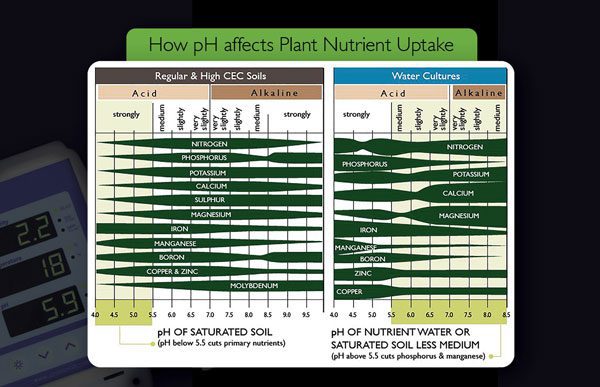A common misconception when feeding plants is that they consume everything we give them at once. Standard plant feeds are a mix of nutrient and additive concentrates, diluted to the required strength. The measurement of strength is referred to as EC (electric conductivity) or PPM (parts per million) and indicates the total amount of nutrient and additive salts contained in the solution. The higher the reading, the stronger the feed; the lower the reading, the weaker it is. It is essential to note that EC and PPM readers cannot read the strength levels of individual nutrient components; only the total amount contained within the solution.
EC and PPM’s are crucial because different crops require various strengths of nutrient solution to thrive. By taking regular readings with an EC reader, growers can fine-tune the strength of the feed and ensure that it remains within the optimum range for each plant. For example, an EC of three or above could pose considerable danger to crops and induce the onset of nutrient burn or nutrient lock. If EC levels are too low, a nutrient deficiency is likely, and your plants will starve.
General EC ranges are as follows:
Herbs: 0.5-1.5 EC
Veg: 1.4-2.4 EC
Tomatoes: 2.2-2.8 EC
Each crop has its own preferred EC, which fluctuates throughout its life cycle. Always be sure to follow the crop’s feeding schedule as carefully as possible.
Understanding Uptake

Let’s use the example of a single herb plant in a DWC (Deep Water Culture) system. The plant spends its entire lifecycle in a reservoir where the roots are suspended in water; no medium is involved. For this example, the herb plant is sitting in 10 litres of the fresh feed solution, and at the time of mixing, the pH is perfect, and the EC is at one.
Let’s say that 24 hours after feeding the water level has dropped 50%, and the EC has risen to two. What has happened? The plant appears to have drunk half of the feed solution, but the EC has doubled.
The first thing to do in a case like this is to check the growing environment. If the room is too warm, the plant may have been transpiring at a faster rate and is now demanding more water. As a result, the plant essentially un-mixes the feed formula, taking up only the water and leaving the nutrients behind. This process increases the EC strength in the reservoir.
Next, check the pH level, as it may have changed. If the pH is too high or too low (the perfect range is generally between 5.5-6.5, depending on what you are growing), certain nutrient and additive elements won’t be absorbed. The plant will likely take up more of the water content of the feeding solution. A pH that is too high can cause nitrogen lockout; a pH that is too low can cause magnesium lockout.
What Not To Do
Once the problem has been discovered, it’s time to correct it. Do not make a top-up feed with more EC; this will put the plant at risk of nutrient burn or nutrient lock.
Nutrient burn happens when the roots consume more nutrients than they can use. This causes issues with water flow in the plant and triggers brown or yellow “burns” on the tips of the leaves. A nutrient lock is when a plant halts further uptake of a feed after realising how strong the solution is. The plant will likely drink an excess of water to rehydrate itself and dilute the high number of nutrients and additives in its system.
Adding more water to the remaining food solution isn’t the answer, either. Unfortunately, EC and PPM readers only give the overall strength of the nutrient solution. They can’t break down what levels of each particular nutrient are present. Therefore, it’s essential to consider that the plant may have taken up excessive amounts of some nutrients, while others may have been partially or entirely locked out. Due to this ambiguity, it’s not clear what the individual nutrient and additive levels are in the solution left in the reservoir.
The Fix

The only course of action, in this case, is to discard the remaining feed in the reservoir and make a fresh batch that has an EC of 1. Afterwards, check the environmental controls to ensure that temperatures and pH levels are where they need to be. Many nutrient brands are pH safe and self-regulate to an ideal pH range. This is an excellent precaution to take when struggling with managing the pH.
Plants should take up nutrients and water in balanced amounts. Measure the EC the day after replacing the feed and checking the environmental controls. If it remains consistent (in this case, 1), then the balance has been achieved. Plants are very selective and will not consume everything they are given. The most successful gardeners respect the laws of nature and work with their plants, not against them.
If I make a second batch of fish emulsion using the same method it is possible not to add fresh lacto pills but add some emulsion from the first batch to start the fermentation?